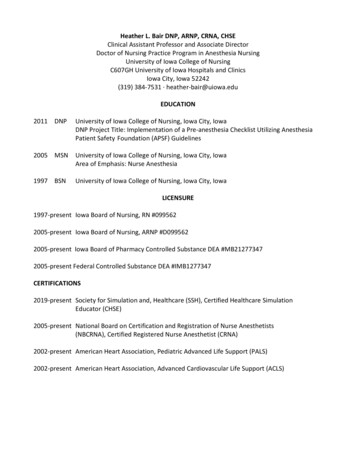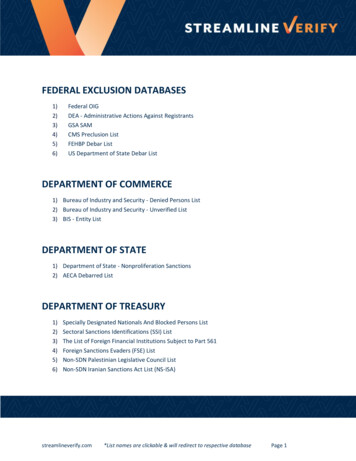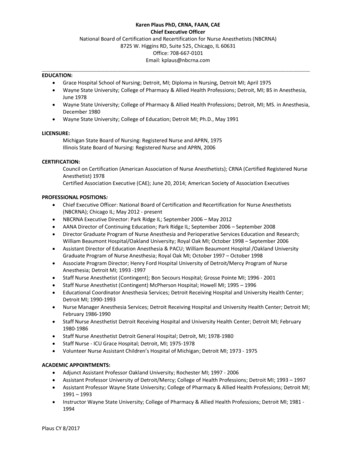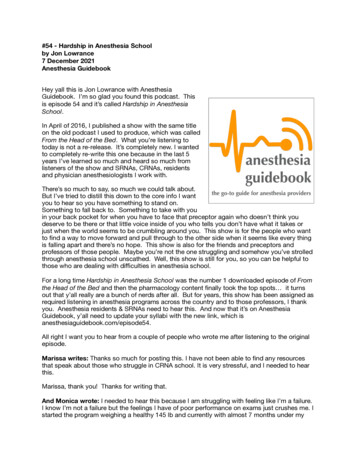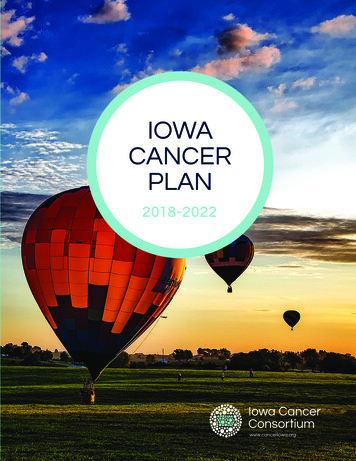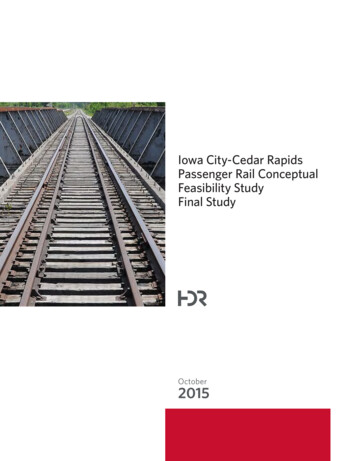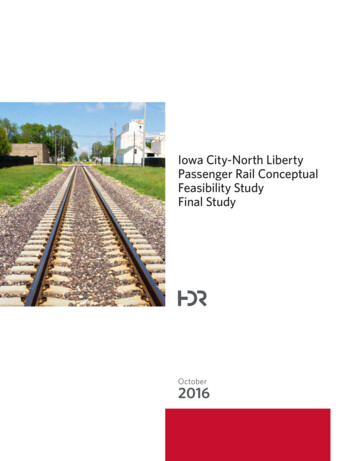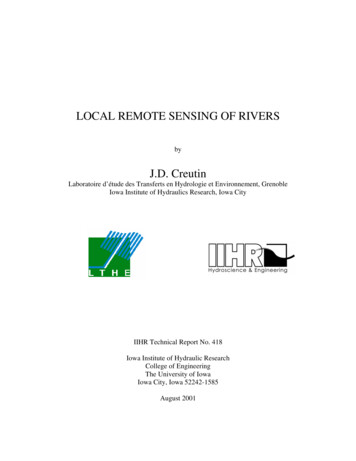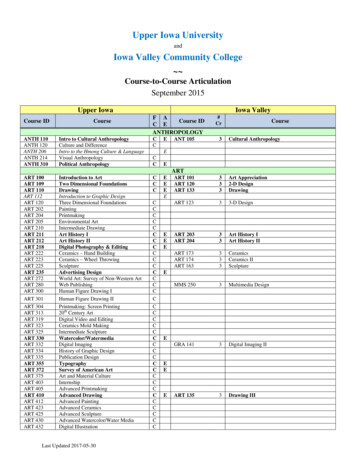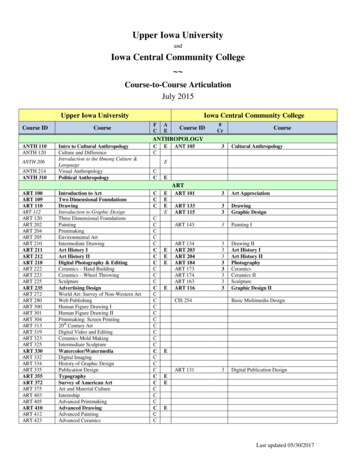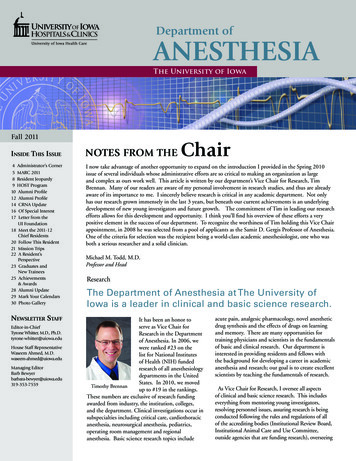
Transcription
Department ofANESTHESIAThe University of IowaFall 2011Inside This Issue4 Administrator’s Corner5 MARC 20118 Resident Jeopardy9 HOST Program10 Alumni Profile12 Alumni Profile14 CRNA Update16 Of Special Interest17 Letter from theUI Foundation18 Meet the 2011-12Chief Residents20 Follow This Resident21 Mission Trips22 A Resident’sPerspective23 Graduates andNew Trainees25 Achievements& Awards28 Alumni Update29 Mark Your Calendars30 Photo GalleryNewsletter StaffEditor-in-ChiefTyrone Whitter, M.D., Ph.D.tyrone-whitter@uiowa.eduHouse Staff RepresentativeWaseem Ahmed, M.D.waseem-ahmed@uiowa.eduManaging EditorBarb Bewyerbarbara-bewyer@uiowa.edu319-353-7559NOTES FROM THEChairI now take advantage of another opportunity to expand on the introduction I provided in the Spring 2010issue of several individuals whose administrative efforts are so critical to making an organization as largeand complex as ours work well. This article is written by our department’s Vice Chair for Research, TimBrennan. Many of our readers are aware of my personal involvement in research studies, and thus are alreadyaware of its importance to me. I sincerely believe research is critical in any academic department. Not onlyhas our research grown immensely in the last 3 years, but beneath our current achievements is an underlyingdevelopment of new young investigators and future growth. The commitment of Tim in leading our researchefforts allows for this development and opportunity. I think you’ll find his overview of these efforts a verypositive element in the success of our department. To recognize the worthiness of Tim holding this Vice Chairappointment, in 2008 he was selected from a pool of applicants as the Samir D. Gergis Professor of Anesthesia.One of the criteria for selection was the recipient being a world-class academic anesthesiologist, one who wasboth a serious researcher and a solid clinician.Michael M. Todd, M.D.Professor and HeadResearchThe Department of Anesthesia at The University ofIowa is a leader in clinical and basic science research.It has been an honor toserve as Vice Chair forResearch in the Departmentof Anesthesia. In 2006, wewere ranked #23 on thelist for National Institutesof Health (NIH) fundedresearch of all anesthesiologydepartments in the UnitedStates. In 2010, we movedTimothy Brennanup to #19 in the rankings.These numbers are exclusive of research fundingawarded from industry, the institution, colleges,and the department. Clinical investigations occur insubspecialties including critical care, cardiothoracicanesthesia, neurosurgical anesthesia, pediatrics,operating room management and regionalanesthesia. Basic science research topics includeacute pain, analgesic pharmacology, novel anestheticdrug synthesis and the effects of drugs on learningand memory. There are many opportunities fortraining physicians and scientists in the fundamentalsof basic and clinical research. Our department isinterested in providing residents and fellows withthe background for developing a career in academicanesthesia and research; our goal is to create excellentscientists by teaching the fundamentals of research.As Vice Chair for Research, I oversee all aspectsof clinical and basic science research. This includeseverything from mentoring young investigators,resolving personnel issues, assuring research is beingconducted following the rules and regulations of allof the accrediting bodies (Institutional Review Board,Institutional Animal Care and Use Committee,outside agencies that are funding research), overseeing
clinical research assistants, and overseeingfunds to make sure they are allocated andbeing used correctly.Michael Todd and Timothy BrennanInteresting Factsabout Timothy J. Brennan, M.D., Ph.D.He completed his doctorate education at the University of Texas Health Sciences Center.He undertook a postdoctoral fellowship in pain neurophysiology at the University ofOklahoma Health Sciences Center. He then undertook his medical education at theUniversity of Oklahoma.He joined the faculty at Iowa in 1993 as an associate of anesthesia, advancing totenured professor status in the departments of anesthesia and pharmacology in 2006.He was named Vice Chair for Research in 2006.He was named the Samir D. Gergis Professor in 2008.He is recognized worldwide for his innovative laboratory work on the mechanisms andtreatment of postoperative surgical pain.The Foundation for Anesthesia Education and Research awarded two grants to Dr.Brennan, a research starter grant in 1993, and a new investigator award in 1995. Henow serves on the FAER Pain Research Council.His research has been funded by the National Institutes of Health for more than 15 years.He has mentored 14 anesthesia and/or pharmacology postdoctoral fellows.He has over 90 published articles, as well as contributing chapters to 8 books.He delivers invited lectures both domestically and internationally. He was selected todeliver a plenary lecture to over 6,000 registrants at the 13th World Congress on Pain inMontreal, Canada, in September 2010, where he spoke on “Pathophysiology of AcutePostoperative Pain.”He received the Kerr Award for Basic Science Research from the American PainSociety-the first anesthesiologist to receive this honor.He serves on multiple professional editorial boards, including his current position asassistant editor-in-chief of Anesthesiology, the largest international anesthesia sourcein the specialty.He has held offices in professional organizations since 1996, was a founding member ofthe acute pain interest group of the International Association for the Study of Pain, andserved as program chair for both the American Society of Regional Anesthesia and PainMedicine and the American Pain Society.He is married to Jacki Brennan, and together they have three children, Corey, Erin, and Ryan.2The basic science laboratories arefunded primarily through grants appliedfor by the individual investigators.Publishing is important to disseminatenew knowledge developed throughour research. Innovation is needed tocontinue receiving grants. Our groupincludes a total of 37 scientists, postdoctoral fellows, scholar/trainees, visitingscholars, graduate research assistants,research fellows, and staff working inbasic science research. Our laboratories’efforts span a wide range of topics. Forexample, our laboratory is examining howincisions cause pain so that new drugsand techniques can be developed to treatacute postoperative pain in patients. Dr.Christina Spofford is developing a modelfor acute pain after back surgery; thismay lead to advances in how to managepatients with chronic pain after surgeryand mechanisms for post laminectomypain syndrome. Dr. Donna Hammondis studying analgesic mechanisms fromthe brain stem that contribute to painrelief produced by many drugs usedclinically now and hopefully in thefuture. Dr. Toshi Kitamoto examinesDrosophila fruit fly behavior in an effortto identify new targets for treatmentsof several diseases including memoryand sleep disorders. Dr. Max Baker ismodifying anesthetic drugs to developnew medicines that could treat a varietyof clinical illnesses.With Dr. Todd’s support, we are fosteringclinical research in the Department ofAnesthesia and this has been one areaof significant advancement in the lastseveral years. Clinical investigators aredeveloping research ideas that begin withcompletion of a simple questionnaireabout their idea. The questionnaireis reviewed by a Clinical ResearchCommittee that includes statistical reviewand support by Dr. Emine Bayman.The initial proposal is discussed ata departmental Clinical ResearchCommittee meeting where members ofthe department review the questionnaireand make recommendations. The clinicalinvestigator is guided by modificationsand suggestions by the committee,thereby facilitating improvements inthe proposal. Our team of research
assistants, led by Pam Jacobs, R.N.,assists the investigator in producing theirInstitutional Review Board (IRB) draft,which undergoes a secondary review priorto the formal submission.Prior to submitting a research projectto the IRB, all investigators are requiredto take an online course regarding theprotection of human subjects in research.Once this training is completed, andthe accompanying test is submitted, aresearcher’s name will appear on Iowa’sCertified Investigator web site. FollowingIRB approval, the researcher is free tobegin his or her study.We have many areas of outstandingclinical research. For example, Dr. BradHindman and colleagues have severalrecent publications that have enabled theteam to obtain an NIH grant to studyintubation mechanics and the cervicalspine. Dr. Avinash Kumar has beenhighly successful evaluating DrotrecoginAlfa in a sepsis trial and Dr. Frank Dexterand colleagues continue their highlyproductive research in operating roommanagement. Dr. Robert Block examinesdrug effects on cognition, learning,and memory in adolescent patients. Inthe future, you will be seeing results ofour research in regional anesthesia byDr. John Laur and colleagues and theperioperative use of ultrasound by Dr.Ken Ueda, Dr. Sundar Krishnan andcolleagues. Other areas of developmentinclude simulation research.Anesthesia fellows, residents, andmedical students also participate inclinical research. As many of ourreaders know, the Midwest AnesthesiaResidents Conference (MARC) wasborn through the foresight of WilliamHamilton, M.D. [See article on page5.] While this meeting has alwaysheld significance for our department,participation has increased markedlyover the past several years. In 2008,15 oral presentations were completedat the MARC conference. In 2009,22 oral presentations were given andin 2010, 9 oral presentations werecompleted. In 2011, we had 28 totalabstracts presented at MARC; 27 oralpresentations and 1 poster presentation.Our researchers also are encouraged toparticipate in the annual Carver Collegeof Medicine, College of Public Health,Institute for Clinical and TranslationalScience and VA Health System ResearchWeek event. Our department presentedseven posters for the research week in2011. For several years our departmenthas sponsored medical students fromthe University of Iowa Carver College ofMedicine and from other institutions.The Foundation for Anesthesia Educationand Research (FAER) created theMedical Student Anesthesia ResearchFellowship (MSARF) to encouragetalented medical students to considercareers in anesthesiology research andperioperative medicine. The MSARFprogram offers medical students an8-12 week anesthesia-related researchexperience and the opportunity to presentresearch findings at the American Societyof Anesthesiologists Annual Meeting.We are fortunate to have as a facultymember biostatistician Emine Bayman,Ph.D., Assistant Professor. Dr. Baymancontributes to the expansion of ourresearch projectsby assisting indesigning researchproposals so that thefuture data analysesare optimized.She is involvedat the beginningof projects, evenprior to thedevelopment of thewritten protocol.Determiningappropriatedesign, statisticalmethodology,sample sizecalculation, andrandomization protocols for clinical studiesare some of the areas that Dr. Bayman hasimproved the research projects. Her reviewof projects and guidance for proceeding areinvaluable to our research teams.Our department boasts basic scienceresearchers, clinical researchers, andtranslational scientists. We currentlyhave 52 active IRB protocols generatedby 23 Principal Investigators. Altogether,40 faculty participate in either basicscience or clinical research and thisresearch generated more than 2.8million in grants for the last fiscalyear. Our senior faculty mentor younginvestigators, helping them develop,advising them, and assisting in gainingfunding. This collaboration is positivefor advancing their careers. We havedeveloped an Intranet-based researchsite, where we post procedures,protocols, and timelines for assistingall researchers within our department.Several of our senior faculty hold jointappointments with other Iowa College ofMedicine departments, allowing for evengreater collaboration on projects.In addition, our senior researchers havedeveloped relationships with colleaguesfrom other institutions, joining withthem in collaborative projects. Thisallows for not only multidisciplinary, butalso multi-institutional initiatives. Thishas resulted in an average of more than40 publications per year since 2006 and avery productive start in 2011 (see graph).We are particularly excited about theDepartment of AnesthesiaPublicationsnumber of new investigators with recentpublications as a result of our clinicalresearch program.The future is bright for research inthe Department of Anesthesia at TheUniversity of Iowa. We consider ourresearch a key component in building anacademic anesthesia department that hasoutstanding clinical care, teaching, andcareer development in research.Timothy J. Brennan, M.D., Ph.D.Samir D. Gergis Professor of AnesthesiaVice Chair for Research3
ADMINISTRATOR’SCornerBack to SchoolJohn Stark, second from right, in class at Dartmouth.As this newsletter is being distributed, school is back in session for yet another academic year. Aside from the increase in Iowa City trafficand the abundance of available student labor, I rarely take notice of this fact, as life in health care administration is much more “corporate”than “academic.” I see the students heading for the library, I recall the all-nighters, excessive coffee and mid-term stress, generally thinking,“I’m glad that is all in the past.” Or so I thought.This past April, I was given the opportunity to enroll in a new program through Dartmouth College called the “Master of Health CareDelivery Science” program (MHCDS). I am one of four University of Iowa Health Care staff to attend as part of the inaugural class of theMHCDS program.This leads to a few questions: What is this program and don’t you already have a master’s degree?In reverse order, yes, I do have my Masters in Business Administration (MBA). I earned this degree from The University of Iowa (UI)immediately following my undergraduate work and prior to my entry into the health care world. The UI MBA program has a significantmix of students from the United States and abroad and a strong focus on teamwork, which gave me a wonderful foundation for generalbusiness administration, as well as the ability to work with groups of diverse people.Having now been in health care administration for a number of years, this new program offers me the opportunity to combine my currentenvironment at UI with the latest academic offerings and research. In order to properly describe this program, I defer to the narrative fromthe Dartmouth web site.“The problems of health care throughout the world are not primarily ones of medical knowledge or even political will but of effectivemanagement and execution. The Master of Health Care Delivery Science (MHCDS) program seeks to deliver this specializedknowledge to a diverse, global group of participants—the managers and professionals who are poised to be the health care leadersof tomorrow.At the heart of the program is a commitment to the value-based improvement of health care delivery—achieving better outcomes forthe same or lower costs—that is scientifically, ethically, and managerially sound.The 18-month program is designed for high-potential change agents: clinicians, administrators, and professionals in health careand related industries. In addition to knowledge and skills, participants will gain tangible results through personal leadershipdevelopment and action-learning projects. Organizations supporting the program will advance their mission of value-basedimprovement as they invest in leadership resources and build their capacity for continual change.”As with most articles I write, I try to circle back to, “How will the UI and/or the Department of Anesthesia be impacted?” First, asreferenced above, is an “action-learning project.” This is an actual UI-based project we will develop during the course of the program withthe goal of implementation once completed. The task we are planning involves the evaluation of the effectiveness of statewide efforts toprovide care to pediatric patients, and what UI Health Care can do to improve these efforts. As we progress toward the new UI Children’sHospital tower, this information will be crucial for future endeavors. Beyond this, studying the science of health care delivery, gaining anunderstanding of patient-focused care and tools to help implement needed change, and the relationships I’ll develop will all be enormouslyhelpful to Anesthesia (in fact, I have two anesthesiologists from Dartmouth-Hitchcock as classmates in the program). I believe theprogram’s content will prove exceedingly beneficial as we continue to grow and evolve in today’s health care market.John Stark, M.B.A.Department Administrator4
MARC 2011Midwest Anesthesia Residents Conference 2011The 2011 Midwestern Anesthesia Residents Conference (MARC)was held at the Marriott Hotel on Michigan Avenue in Chicago, IL.Each year, MARC is hosted by one of the midwestern anesthesiadepartments. But this year was very, very special.Fifty years ago, Dr. WilliamHamilton (BA ’43, MD ‘46,R ’51), former Head of Iowa’sDepartment of Anesthesiafrom 1963-1967, organizeda small multidepartmentanesthesia meeting. It wasdesigned to bring togetherprograms in the Midwest andto promote the exchange ofinformation about clinical careand basic science research, withHonary Speaker William Hamiltona focus on residents. This firstmeeting was small, perhaps 30-50 attendees, and was held inIowa City, IA, as were the next four, before the meeting began torotate to other departments.But from small beginnings . Over the years, the MARCmeeting has grown and grown -- and grown -- eventually exceedingall of Dr. Hamilton’s wildest expectations. The 2011 MARCmeeting set a new standard, with a whopping 766 registeredparticipants from 33 institutions. While some might quibble, thisshould make MARC 2011 the fourth largest anesthesia meetingin the country – and certainly, the largest resident get-together inthe world! It was only fitting that its founding institution, TheUniversity of Iowa, host the 50th anniversary meeting.This year, the two “senior” bosses of MARC, Michael Todd, M.D.,and Mazen Maktabi, M.D., (R ’87, F ’88, Faculty ’89-’11) hadthe audacity to ask two young faculty members to join them inorganizing this magnum event (something that clearly demonstratesthe department’s commitment to promote the academic growth anddevelopment of its junior faculty). This youthful input played abig role in the success of the meeting. Hours, days, and weeks werespent on refreshing the face of the meeting, giving it a more youthfullook. Novel ideas were brought to the table. As Virgil once said,“possunt quia posse videntur” (“they can because they think they can”).Believing that we could, we did. We wanted to implement new ideasOrganizers: Mazen Maktabi, Brent Hadder, Michael Todd and Esther Benedettithat could be carried forward to future meetings, not just gimmicks forone meeting. And, indeed, we hit a Grand Slam.What were these new ideas? First, we partnered with anextraordinary management company, NHS Management Services, tomanage the meeting. This is only the second time that MARC hasrelied on an “outside” organization to aid in the meeting; however,as the meeting has gotten larger and larger, it became apparent thatsome truly expert help was needed. This was also the first time that aMARC meeting was held outside of the “host city.” We would haveloved to hold it in Iowa City, but there was simply not enough hotelcapacity for something this large. And the payoff was the smoothestrun MARC meeting ever (and we aren’t just making this up, we’veheard from dozens and dozens of attendees). However, given thissuccess, it’s a certainty that this won’t be NHS’s last MARC meeting.In fact, they are already actively involved in planning the MARCmeetings for the next five years.Another first in 2011 was the addition of a chief residents meeting,in which outgoing and incoming chief residents from all the memberinstitutions were invited to discuss and exchange ideas that couldpotentially benefit all residency programs involved, as well as alsoto give us ideas for improving future MARC meetings. This ideacontinued on page 65
arose from the recognition that there are very few opportunities forresidents to meet together and discuss the pros and cons of theirrespective programs, and while MARC was FOR our residents, ithad never before involved the residents in its planning. The secondannual chief’s meeting is already scheduled for next year.From the beginning, some sort of entertainment on Saturday nighthas been the standard for MARC. It has usually been relativelytraditional: a cocktail party, a musical or comedy group, a visit toan aquarium, etc. We wanted to do something that was more inkeeping with the youthful nature of our residents, and we came upwith a good one. We selected The Hard Rock Café as the venueDan Gable, UI wrestling coach from 1972-1997. The opportunityto hear the story of how a young Iowa wrestler become a legendaryOlympic gold medal winner and the most successful wrestling coachin the nation, through years of dedication, struggle, and focus was noless than inspiring. Mr. Gable’s message was that of how the key tosuccess in leading and inspiring excellence in a group is by exaltingthe specific attributes and interests of each individual in the team,rather than focusing on a recipe “same for all” approach.Everyone loves to achieve success, and what better way to win thanto be publically recognized for your effort. So, on Sunday, wegathered together one last time to honor the award winners. OurMARC attendees letting their hair down at the Hard Rock CaféFaculty judges Michael Todd and Jerry Cohenfor our social program, and we held it on the Saturday night of theNCAA Final Four. It was appropriately entitled MARC Madness.Here, even the most industrious of the attendees managed to “lettheir hair down” and relax in a fun, friendly, and full of rock-‘n’-rollenvironment. Detail was paid to each interest in the room. Forthe hungry, there was delicious food served. For the musicians, alarge array of tunes was played. For the sportsmen in the house,there were big screen televisions showing the NCAA finals. For thecollectors, popcorn filled Hard Rock Café/MARC shot glasses weregiven out as souvenirs. For all, there was the possibility to mingleand celebrate the close of a truly magnificent day.department considered, again for the first time in MARC history, togive recognition not only to first place victors, but also to distinguishthe second and third place winners. Certificates were awardedthem all, and as an extra perk, we awarded first place holders with acollector’s Hard Rock Café guitar pin. The University of Iowa cameout with three first places, four second places and one third place.This represents more than years prior, making our way ahead in thegame. And to wrap up this victory, mention must be made of a jampacked room at the close of our meeting, until the very end, whereextraordinary prizes were given out to those who luckily held thewinning tickets! All wished for iPods, Wiis, Xboxes, Nooks, and more,We also had the good fortuneof having three excellentguest speakers. First, andperhaps most importantly,we had the honor of havingDr. Hamilton as an honoraryspeaker, celebrating thecreation, birth, growth, anddevelopment of his historicidea. How many of us havethe chance to see the 50thanniversary of somethingDan Gablewe created, something thathas grown so far beyond its original humble model? We were alsojoined by Jerry Cohen, M.D., President-Elect of the AmericanSociety of Anesthesiologists, who also graciously volunteered as ajudge for several presentation sessions. Finally, we had Iowa’s own6Residents at the Hard Rock Café
but only were received by a few! The residents were content, happyabout having a meeting that was truly for them and about them.Additional individuals deserve credit for the success of MARC.There was the team from NHS Management Services, as wellas our department’s Lorri Barnes, each working to assure thesuccess of the event. Four 2011 Iowa resident graduates, Drs.Burke O’Neal, Geoffrey Kredich, Angela Ko, and John Kleinunselfishly volunteered many hours to aid in the behind-the-scenesfundamentals, such as registration, guiding people to destinationsand answering a myriad of questions. The number of Iowa facultywho participated set a record for our department.This year’s MARC will be remembered for years to come, and asJohn Quincy Adams said, “If your actions inspire others to dreammore, learn more, do more, and become more, you are a leader.”And that we are!Anesthesia Faculty and residents at the Hard Rock CaféEsther M. Benedetti, M.D., F.I.P.P.Clinical Assistant ProfessorBrent Hadder, M.D. (R ’08, F ’09)Clinical Assistant ProfessorA poster presentationA very tired Brent HadderResidents have a good laugh with faculty member, Dr. Joss ThomasDavid Dull, M.D. (R ‘87, F ‘88)Check out ourOnline Photo GalleryWe are improving our skills of photographically capturing people and events our department sponsors – so much so that we can’t fit all of thepictures we would like to share with you in our print newsletters (pg. 30). Thus, we invite you to view a more expansive Photo Gallery storedwith the electronic version of this newsletter issue.Please spend a few minutes enjoying these photos: www.anesth.uiowa.edu/portal/?tabid 7977
Drs. Hine, delCastillo, Heller and Floyd(L to R) making a bet over who will win.ResidentIn 2001, an educational spin on thepopular game show Jeopardy! made adebut in our department as a teachingtool. Launched by Phillip G. Schmid,III, M.D. (MD ’89, R ’93, Faculty’99-’01, currently working in Eagle,Idaho) and Debra Szeluga, Ph.D.,M.D., Associate Professor, Vice Chairfor Education, and Residency ProgramDirector, the Iowa Anesthesia Jeopardystarted out as a home grown, lowtech computer program with buzzers.Christina SpoffordResidents enjoyed shouting out answersto a wide range of questions on every topic of anesthesia. Thefun and interactive atmosphere allowed resident participantsand audience members to recall facts that are frequently on theAmerican Board of Anesthesiologists Certification Exam.From 2004-2010, Anesthesia Jeopardy in our department tooka hiatus. Loading questions in the system took hours, not tomention the time to write them. However, in 2010, we relaunched a new and improved version, using more sophisticatedhardware and software. This new gaming console allows residentsto have game controllers, sound effects, and a projected gameboard similar to the real game.The game starts with a single Jeopardy round that includes sixcategories; residents choose a category and the amount they want tobet. As in the real TV show, wrong answers result in values beingdeducted. We take a short break before double Jeopardy, and thenthe residents answer a final Jeopardy question. The computer keepstrack of the points and the team that buzzes in first. There are threeresident teams consisting of one CA-3, one CA-2 and one CA-1resident each. Although our residents don’t take home the bigmoney like contestants on the popular television show, these ninebrave residents are rewarded with prizes ranging from coffee housegift cards to scrub hats to board review books.Topics cover all aspects of perioperative care, pain medicine, andintensive care with clever titles such as: “just kidding” (pediatrics),“past gas” (history), and “road rage” (satellite anesthesia). Wealso include a category called “I see,” where images are displayedand residents have to answer subsequent questions (See imageabove). This helps residents learn how to read and interpret x-rayand computerized tomography images, echocardiography loops8and regionalultrasoundimages, inaddition tothe standardanatomyRecent “I See” question about TEE: A 55 yearimages.old man presents with acute, severe, chest pain.SubspecialtyThe following image of the aorta is obtained onfacultyTEE. These two drugs would be important toadminister prior to induction of anesthesia.members helpwrite and editquestions andare present in the audience to provide clarification and education.As educators, we are constantly seeking novel teaching tools thatmeet the needs of our residents. Most of our current residentsare classified as millennial learners, making them adept at usingnew technology and computational forms of learning. They alsotend to learn best in interactive formats, such as problem-basedlearning discussions. Therefore, we have continually modifiedand improved our curriculum to provide increasing educationalsessions in these formats. Anesthesia Jeopardy is an effective toolfor teambuilding. It provides high-yield factual recall and bringsout a competitive edge! It even can lead to friendly monetarybetting over the likely winners (see above photo).The residents who have participated have enjoyed the experience.Lee Kimball, M.D. (MD ’07, R ’11), was a recent participant andhad this to say about Iowa Anesthesia Jeopardy: “The ability toanswer board style questions in a nonthreatening atmosphere makesthe game a worthwhile investment of time. The game also allowsyou to think on your feet. Overall, it is a great experience.”We look forward to our next session on January 18, 2012. If youare free at 5:00 p.m., please join us, and see how many questionsyou can get right! If you are interested in submitting a questionfor Iowa Anesthesia Jeopardy, or an image for the “I see” segment,please send your submission to Dr. Chris Spofford at christinaspofford@uiowa.edu. The first ten submissions will receive a prize!Christina M. Spofford, M.D., Ph.D.Assistant ProfessorR ’07, F ‘08
Help Our Students Travel PROGRAMEdito
Alfa in a sepsis trial and Dr. Frank Dexter and colleagues continue their highly productive research in operating room management. Dr. Robert Block examines drug effects on cognition, learning, and memory in adolescent patients. In the future, you will be seeing results of our research in regional anesthesia by Dr. John Laur and colleagues and the
